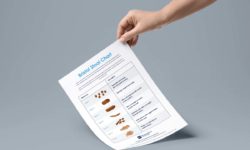Bristol stool form scale
Originally published on: April 6th, 2017. Last modified on January 29th, 2022
Different people have different bowel habits. Most people who have a bowel movement more than 3 times a week and pass good textured faeces (not too hard or soft) can be said to have ‘normal’ bowel behaviour.
Since it can be hard to state what is normal and what is abnormal, some health professionals use a scale to classify the type of stool passed. This helps assess how long the stool has spent in the bowel.
Type 1 has spent the longest time in the bowel and type 7 the least time. A normal stool should be a type 3 or 4, and depending on the normal bowel habits of the individual, should be passed once every one to three days.
Download the Bristol Stool Chart below.
Bristol Stool Chart
[BBC:002] Bristol Stool Chart
The Bristol Stool Chart is used by medical professionals as an aid to assessing the condition of the bowel.
Stool Form Types 1 to 7
If you’d rather reference the scale directly below, with short descriptions of each type of stool. We offer the PDF for a full reference guide, which is often used by clinicians and patients alike.

Separate hard lumps,
like nuts (hard to pass)

Sausage shaped but lumpy

Like a sausage but with cracks
on the surface

Like a sausage or snake,
smooth and soft

Soft blobs with clear cut edges
(passed easily)

Fluffy pieces with ragged edges,
a mushy stool

Watery, no solid pieces,
entirely liquid
Further Information
If you’ve noticed a change in your stool which concerns you, the best thing to do is visit your GP or healthcare professional. Often you will find a local continence clinic will be able to help, with specialists in helping people manage their bladder or bowel health on a day to day basis.

